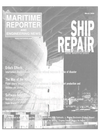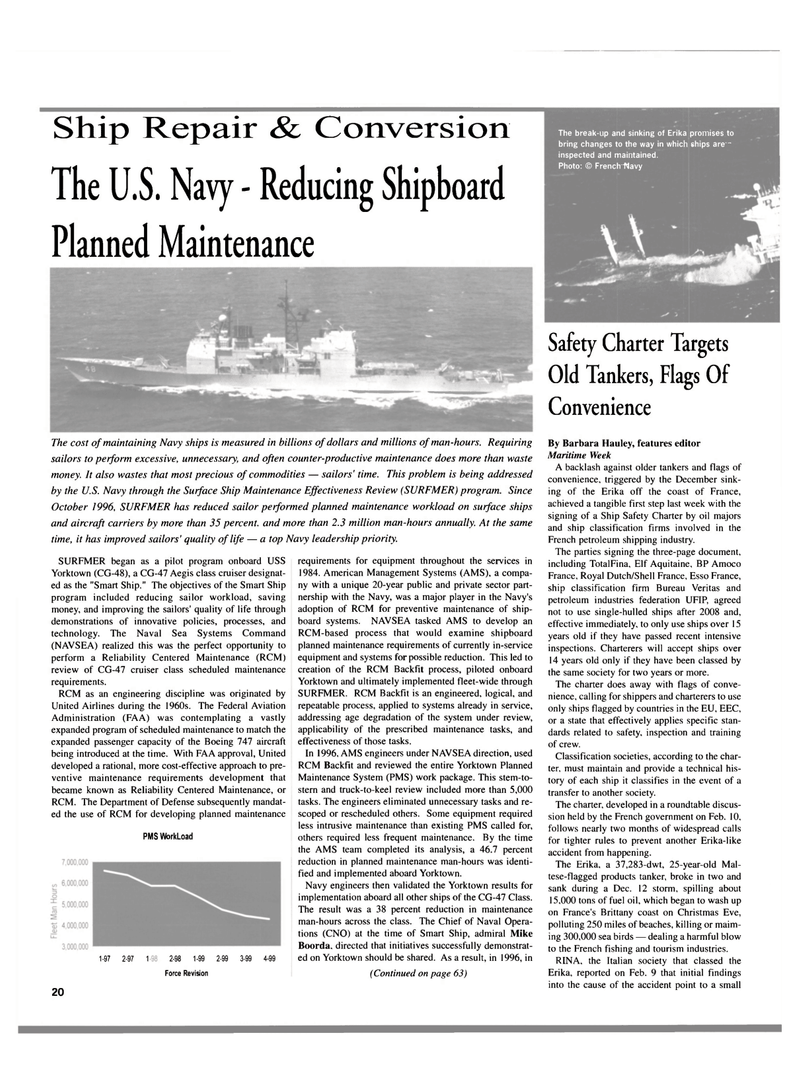
Page 20: of Maritime Reporter Magazine (March 2000)
Read this page in Pdf, Flash or Html5 edition of March 2000 Maritime Reporter Magazine
The break-up and sinking of Erika promises to bring changes to the way in which ships are- inspected and maintained.
Photo: © French "Navy
Ship Repair & Conversion
The U.S. Navy - Reducing Shipboard
Planned Maintenance
The cost of maintaining Navy ships is measured in billions of dollars and millions of man-hours. Requiring sailors to perform excessive, unnecessary, and often counter-productive maintenance does more than waste money. It also wastes that most precious of commodities — sailors' time. This problem is being addressed by the U.S. Navy through the Surface Ship Maintenance Effectiveness Review (SURFMER) program. Since
October 1996, SURFMER has reduced sailor performed planned maintenance workload on surface ships and aircraft carriers by more than 35 percent, and more than 2.3 million man-hours annually. At the same time, it has improved sailors' quality of life — a top Navy leadership priority.
SURFMER began as a pilot program onboard USS
Yorktown (CG-48), a CG-47 Aegis class cruiser designat- ed as the "Smart Ship." The objectives of the Smart Ship program included reducing sailor workload, saving money, and improving the sailors' quality of life through demonstrations of innovative policies, processes, and technology. The Naval Sea Systems Command (NAVSEA) realized this was the perfect opportunity to perform a Reliability Centered Maintenance (RCM) review of CG-47 cruiser class scheduled maintenance requirements.
RCM as an engineering discipline was originated by
United Airlines during the 1960s. The Federal Aviation
Administration (FAA) was contemplating a vastly expanded program of scheduled maintenance to match the expanded passenger capacity of the Boeing 747 aircraft being introduced at the time. With FAA approval, United developed a rational, more cost-effective approach to pre- ventive maintenance requirements development that became known as Reliability Centered Maintenance, or
RCM. The Department of Defense subsequently mandat- ed the use of RCM for developing planned maintenance
PMS WorkLoad 1-97 2-97 1 2-98 1-99 2-99 3-99 4-99
Force Revision requirements for equipment throughout the services in 1984. American Management Systems (AMS), a compa- ny with a unique 20-year public and private sector part- nership with the Navy, was a major player in the Navy's adoption of RCM for preventive maintenance of ship- board systems. NAVSEA tasked AMS to develop an
RCM-based process that would examine shipboard planned maintenance requirements of currently in-service equipment and systems for possible reduction. This led to creation of the RCM Backfit process, piloted onboard
Yorktown and ultimately implemented fleet-wide through
SURFMER. RCM Backfit is an engineered, logical, and repeatable process, applied to systems already in service, addressing age degradation of the system under review, applicability of the prescribed maintenance tasks, and effectiveness of those tasks.
In 1996, AMS engineers under NAVSEA direction, used
RCM Backfit and reviewed the entire Yorktown Planned
Maintenance System (PMS) work package. This stem-to- stern and truck-to-keel review included more than 5,000 tasks. The engineers eliminated unnecessary tasks and re- scoped or rescheduled others. Some equipment required less intrusive maintenance than existing PMS called for, others required less frequent maintenance. By the time the AMS team completed its analysis, a 46.7 percent reduction in planned maintenance man-hours was identi- fied and implemented aboard Yorktown.
Navy engineers then validated the Yorktown results for implementation aboard all other ships of the CG-47 Class.
The result was a 38 percent reduction in maintenance man-hours across the class. The Chief of Naval Opera- tions (CNO) at the time of Smart Ship, admiral Mike
Boorda. directed that initiatives successfully demonstrat- ed on Yorktown should be shared. As a result, in 1996, in (Continued on page 63) 20
Safety Charter Targets
Old Tankers, Flags Of
Convenience
By Barbara Hauley, features editor
Maritime Week
A backlash against older tankers and flags of convenience, triggered by the December sink- ing of the Erika off the coast of France, achieved a tangible first step last week with the signing of a Ship Safety Charter by oil majors and ship classification firms involved in the
French petroleum shipping industry.
The parties signing the three-page document, including TotalFina, Elf Aquitaine, BP Amoco
France, Royal Dutch/Shell France, Esso France, ship classification firm Bureau Veritas and petroleum industries federation UFIP, agreed not to use single-hulled ships after 2008 and, effective immediately, to only use ships over 15 years old if they have passed recent intensive inspections. Charterers will accept ships over 14 years old only if they have been classed by the same society for two years or more.
The charter does away with flags of conve- nience, calling for shippers and charterers to use only ships flagged by countries in the EU, EEC, or a state that effectively applies specific stan- dards related to safety, inspection and training of crew.
Classification societies, according to the char- ter, must maintain and provide a technical his- tory of each ship it classifies in the event of a transfer to another society.
The charter, developed in a roundtable discus- sion held by the French government on Feb. 10, follows nearly two months of widespread calls for tighter rules to prevent another Erika-like accident from happening.
The Erika, a 37,283-dwt, 25-year-old Mal- tese-flagged products tanker, broke in two and sank during a Dec. 12 storm, spilling about 15,000 tons of fuel oil, which began to wash up on France's Brittany coast on Christmas Eve, polluting 250 miles of beaches, killing or maim- ing 300,000 sea birds — dealing a harmful blow to the French fishing and tourism industries.
RINA, the Italian society that classed the
Erika, reported on Feb. 9 that initial findings into the cause of the accident point to a small

 19
19

 21
21
